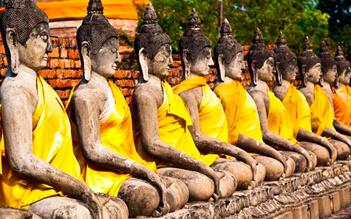Overview
About Sukhothai
Sukhothai was voted as a Unesco World Heritage City, it has a vast number of historical sites and ruins temple. Once the first capital of Siam Kingdom, the Sukhothai was a cradle of Thai civilization – the home of Thai art, architecture, and language. The name ‘Sukhothai’ means ‘dawn of happiness’, and the kingdom had enjoyed a long period of peace and prosperity. In addition, to visit the historical sites, Sukhothai is a quiet small city where tourists can relish the charms of Thailand’s rustic lifestyle.
Top Tourist Attractions
Sukhothai Ancient City
This World Heritage site is known as a testament to Thailand storied past. About 200 temples were excavated and reconstructed, giving visitors a clear look at how Thailand's ancient capital might have been like. This was a cradle of Thai culture. Archaeologists have found the remnants of early religious works that can define a society. In those heyday, three earthen walls along with two moats surrounded the ancient center were established. For visitors' convenience, there is an information center and information boards available in English outside the buildings.
.jpg)
Sukhothai
Wat Mahathat
The most splendid and one of the most important ruins in Thailand is the Wat Mahathat. It was near the earlier Royal Palace which is a wooden building, and this wat covers an area up to 4 ha, surrounded by six wi-harns of varying size, 185 chedis, and eleven sa-las. The main chedi also most impressive is located at the center of the site, with both a wi-harn and a bot. Established in the Sukhothai style, its top is crowned by a lotus bud. The middle resembles the Khmer prangs and the square base is sculptured with a procession of worshippers including 40 figures that is 1 m high on each side. 4 niches of the four corner chapels define fine stucco work, the life of Buddha, and gods against demons in conflict. The center chedi contains a golden statue of the Phra Buddha Shakyamuni which King Rama had brought to the Wat Suthat in the late 18th.
Wat Traphang Ngoen
To the west of Wat Mahathat, located an island covered with the lotus in the Traphang Ngoen - Silver Lake, the outstandingly beautiful chedi of the Wat Traphang Ngoen and the columns from a large wi-harn. Mountains form the background of the chedi, which holds statues of Buddha in its niches and is crowned by a lotus bud.
Wat Sra Si
Wat Sra Si makes a unique Thai picture, as stands on an island in a pond surrounded by lotus buds. The wat must be a magnificent sight if it stood in all its glory. Ten chedis still stand, as six rows of columns still do and the beautiful statue of a Buddha. Some of the wat's buildings are still inhabited. This is where Loy Kratong - the light festival is celebrated every November, burning the lake with thousands of tiny floating candles.
.jpg)
Sukhothai
How to get to Sukhothai
Getting to Sukhothai by plane
There is a short route from Bangkok's Suvarnabhumi airport to Don Mueang to Sukhothai's airport offering two flights by two airlines every day.
Nok Airways is a Thailand's budget carrier, it offers flights departing from Don Mueang in nearly 2.5 hours.
Bangkok Airways offers flights departing from Suvarnabhumi and spending only 1.5 hours. For the extra few dollars, Bangkok airways give a more streamline and faster service.
Getting to Sukhothai by train
There are no railway stations at Sukhothai. The nearest station is located in the town of Phitsanulok which is one hour by bus to Sukhothai.
Trains leave 7 times daily from Bangkok' railway station to Phitsanulok province with the first train departing at 05.50 and the last at 19.30. The train departs from Bangkok to Phitsanulok spends 7 hours.
From the Phitsanulok train station, take a local bus or a Tuk Tuk to the bus terminal and onwards to Sukhothai it only takes 1 hour.





